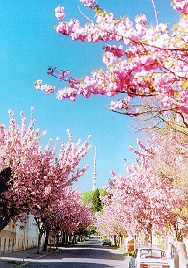
The first mention of the hilly area south of Sopron where master archers from the whole country were drafted to for guard duty was recorded in the year 1225. Development in the area began during the middle years of the 19th century when the first summer houses were beginning to be built in its orchards. Alsó Lõverek, an area of small town character, (Lower Lõvers) lies closer to the city separated from the more sparsely built up Felsõ Lõverek (Upper Lõvers) by the narrow strip of forest along Sörházdomb (Brewhouse Hill). A round-trip by car or bus is probably the most convenient way of discovering the villa quarter of Alsó Lõverek. We begin our journey via the modern underpass and Ady Endre út (Endre Ady Road) that leads to the suburb of Bánfalva. Our route will soon take us past Erzsébet kert, (Elisabeth Gardens) a splendid five hectare public park purchased by the city in 1763 and originally laid out in the French manner. Previously called Neuhof, (German for New Court) Hungary's oldest public park was renamed in the honour of the Empress Elisabeth on he occasion of the millenium celebrations in 1896. The buildings of Sopron University are situated near Erzsébet kert.
They include the building of the former Royal Army Cadet School constructed according to Ignác Alpár's designs in 1893.
Lõver körút (Lõver Ringroad) that separates the Lower and Upper Lõvers branches off Ady Endre út. Some 19th century villas still line Felsõ Lõver út (Upper Lõver Street). In the background Nándor magaslat (Nándor Point) commands the scene from a height of 324 metres. We now reach the Lõver Swimming Pools and the Printz memorial rest dating from 1925. Soon a side road north branches off to 300 metre high Sörházdomb and another south to the belvedere at Károly-magaslat (Charles Point).
To see the building of the state sanatorium take the turning from Lõver körút into Várisi út. In the opposite direction, not far from this crossing at the corner of Villasor (Villa Row) stands the Nepomuki Szent János kápolna (Chapel of St John of Nepomouk). It was originally situated at Elõkapu, obstructing construction work on the new Town Hall. It was therefore demolished, transported stone by stone and rebuilt on the present site in 1899. Walking along Villasor it is possible to enjoy an almost genuine turn of century atmosphere.
Lõver körút continues in Mikovinyi út. The baroque Maria statue standing at the junction was transferred to the site after much restoration work in 1930. The festooned 'cork-screw' column dates from 1700. It supports the figure of the Immaculate Virgin.
And now dear Visitor, let us, before we return to the inner city via Mikovinyi út and Bajcsy-Zsilinszky utca, take a parting look at the botanic gardens surrounding the erstwhile Royal Army Cadet School, now university buildings.
These were the sites we were able to show you in the course of our walks. We hope you have enjoyed yourself and are going to visit us again. No matter whether solo or in a group, for a short while or a stay of some length, allow us to look after you. Please call at any of the local travel agencies to pick up accommodation, guided tour or general programme suggestions. Should you wish for a relaxing stay, further walks in the Sopron hills and the surrounding countryside await you.
The second volume of our book will then, we hope, take you by the hand again.
Walks . . . * Welcome * 1. walk * 2. walk * 3. walk * 4. walk